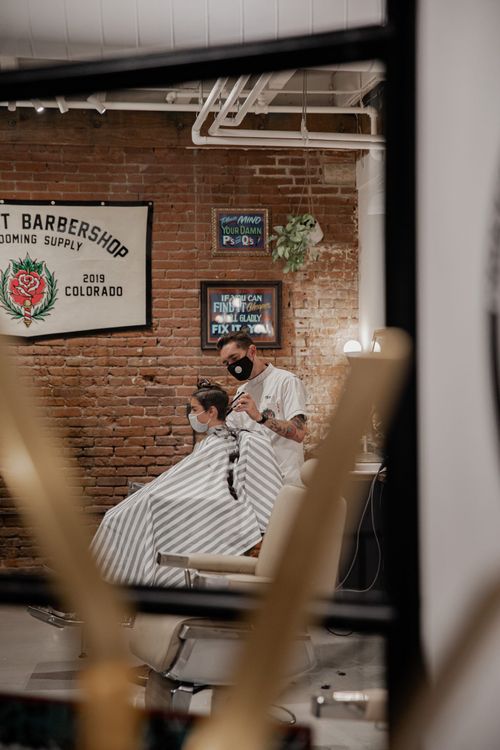Generally, when there is a high risk of Covid-19 you are not recommended to visit any hair salon. Many states in the U.S have shut down salons for hairstylists as part of the shelter-in-place or stay-at-home directives. Now when they are open customers may worry if it is safe to go to the hair salon once these limitations are relaxed and beauty establishments reopen, while stylists must know how to protect themselves.
Hair Salon Risks During COVID-19
As the salons are now open many people wonder what risks are there connected to the pandemic. What should hairdressing look like during a pandemic? Is it possible to get infected from the master’s tools? Where can I do a safe procedure now? To answer all the questions of concern, the Alabama government has made a special Guidelines for Safeguarding All Businesses. The minimal criteria should be implemented into the building for close contact with personal service firms and providers, in addition to the cleanliness requirements imposed by state licensing bodies and the Alabama Department of Public Health. The hairdressing shops are mostly open to operating.
However, while most states, like Illinois, have opened the services, for example, the Los Angeles Department of Public Health changed its Reopening Protocol for Personal Care Establishments, allowing estheticians, hair salons, and barbershops to operate indoors only at a 20% occupancy level.
So, the regulations are different but some of the factors of the pandemic are the same.
COVID-19 Air transmission
The first and overall question remains if you can get infected just by visiting the salon. However, there is no such data yet. COVID-19 is a fairly new virus, the main identified method of its transmission is airborne, airborne dust when sneezing and coughing and contact through touching infected surfaces (in the future, the virus easily penetrates the body by touching the mucous membranes of the mouth, nose, eyes).
Prevention of infection is keeping a distance and wearing personal protective equipment. During the hairdressing in the salon, there is close contact between the client and the master, and infection can occur through the respiratory transmission mechanism, and not through the contact. This is also facilitated by an office with poor ventilation, in which there are no special air purifiers and quartz, and the master himself is a sick or asymptomatic carrier of the virus.
Can I get infected with coronavirus through hairdressing tools?
First of all, let’s understand if it’s possible. As WHO claims an “aerosol” capable of infecting others spreads to a distance of one to two meters from an infected person, while there are less than 50 centimeters between a specialist and a client. And if during a normal conversation up to 200 pathogenic particles are released within a minute, then when coughing and sneezing — from ten to 50 thousand.
It is also dangerous to visit the masters because in beauty salons or at home in most cases there are no ultraviolet installations and quartz, which increases the risk of spreading the virus at times. If there is no urgent need to go to a specialist, then it is better to take care of yourself. Let it be not quite professional, but it is reasonable.
Signs a Hair Salon is Following Guidelines
Ideally, the salon should have you in a separate room. If there is no such thing in the salon, a distance of at least 1.5 meters must be observed with other visitors: you must sit across one table from another visitor. And, of course, stay in the mask throughout the procedure, just like your master. Yes, it’s inconvenient, but it’s safe.
Secondly, the master is obliged to change gloves and masks after each client – keep an eye on this.
Make sure your hairdresser has treated his hands with antiseptic and put on a new mask. Any mask remains safe for two hours, that is, after one session it is no longer usable. Remember that the virus is active on various surfaces for up to three days — before you sit down at the table, the master must wipe the table, chair, and everything you can touch with antiseptic. If he doesn’t do it, ask.
Besides, it’s always better to check out if your master has an Alabama Barber License as it guarantees the surveyance of all requirements.
How to Stay Safe at a Hair Salon Right Now
There are many things you can do to keep safe when visiting salons during pandemics. Let’s discuss some of them.
- Always Wear a Mask
You should always wear a mask in public. The law also applies to salons. If you are just attending the salons for hair service you can wear the mask all the time.
- Avoid touching any surface
As the COVID-19 is spreading via the touching. You are recommended not to touch any tools or surfaces until they are sanitized. Ask the staff to wash their hands before working.
- Sanitized equipements
The majority of salon operations need skin-to-equipment contact. Other surfaces and consumers have been touched by the equipment, such as scissors or combs. As a result, you should request that the staff sterilize and clean the equipment before use.
To sum up…
You should only visit a salon if it is really necessary. Try to do one thing at a time. You can also lower your risk by choosing procedures that require less close contact. Also, visit at different times of the day when it is less crowded. It’s always better to make an appointment beforehand.

